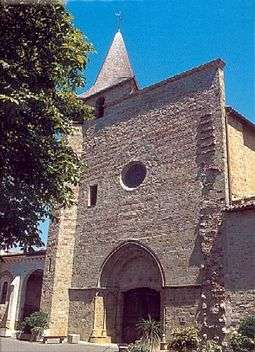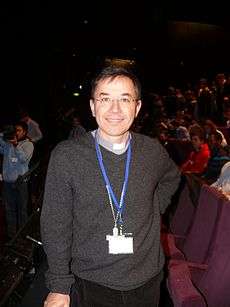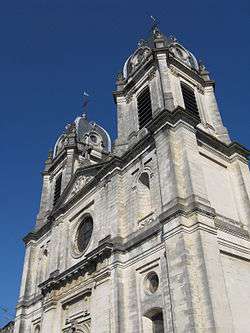Roman Catholic Diocese of Aire and Dax
| Diocese of Aire et Dax Dioecesis Aturensis et Aquae Augustae Diocèse d'Aire et Dax | |
|---|---|
 | |
| Location | |
| Country | France |
| Ecclesiastical province | Bordeaux |
| Metropolitan | Archdiocese of Bordeaux |
| Statistics | |
| Area | 9,364 km2 (3,615 sq mi) |
| Population - Total - Catholics |
(as of 2012) 377,381 264,000 (70%) |
| Information | |
| Denomination | Roman Catholic |
| Sui iuris church | Latin Church |
| Rite | Roman Rite |
| Established | Name Changed: 3 June 1857 |
| Cathedral | Cathedral of St-Jean-Baptiste, Aire |
| Co-cathedral | Cathedral of Nôtre Dame in Dax |
| Patron saint | Notre-Dame de Buglose |
| Current leadership | |
| Pope | Francis |
| Bishop | Nicolas Jean-Marie Souchu |
| Metropolitan Archbishop | Cardinal Jean-Pierre Ricard |
| Emeritus Bishops |
Philippe Jean Louis Breton (2002-2012) Herve Gaschignard (2012-2017) |
| Website | |
| Website of the Diocese | |
The Roman Catholic Diocese of Aire and Dax (Latin: Dioecesis Adurensis et Aquae Augustae; French: Diocèse d'Aire et Dax) is a diocese of the Latin Rite of the Roman Catholic Church in France. The diocese comprises the department of Landes, in the Region of Gascony in Aquitaine.
It was a suffragan of the Archdiocese of Auch under the old regime, but was not re-established until 1822, when it was again made a suffragan of the re-established Archdiocese of Auch, and was assigned the territory of the former Diocese of Aire and Diocese of Acqs (Dax).[1] It is now a suffragan of the Archdiocese of Bordeaux.
It has been known since 1857 as the Diocese of Aire and Dax.[2]
It is a co-cathedral diocese, with episcopal seats in the Cathedral St-Jean-Baptiste d' Aire[3] and in Nôtre Dame de Dax.
On April 6, 2017, the resignation letter of recent Bishop Herve Gaschignard was officially accepted by Pope Francis following allegations that Gaschignard engaged in inappropriate behavior with young people.[4][5]
History
The first reference to a bishop of Aire, on the river Adour, in history is to Marcellus, represented at the Council of Agde, 506.[1] Aire was also the home of St. Philibert; it numbered among its bishops during the second half of the sixteenth century François de Foix, Count of Candale, an illustrious mathematician, who translated Euclid and founded a chair of mathematics at the University of Bordeaux,[1] though he never visited his diocese.
In 1572, on the death of Bishop Christophe de Candale, the Capitular Vicar of Aire submitted a status report (pouillé) to King Charles IX, providing a picture of the diocese at that time. There were two Archdeacons, that of Marsan and that of Chalosse. In addition to the two archdeacons, the Cathedral Chapter was composed of ten Canons and seven Prebendaries, two semi-Prebendaries, the Master of the Children of the Choir, and the Basse-Contre. The Statutes of the Chapter were confirmed by Bishop Tristan d'Aure in 1459 or 1460.[6]
Religious establishments included:
- the Abbaye du Mas d'Aire[7] (O.S.B.: four religious, a Prior, a Sacristan, a Chamberlain and an Almoner; eleven other positions vacant)
- the Abbaye de St-Jean de la Castelle (Premonstratensians: six religious priests, a child servant, and a soldier, though there were places for 18-20 religious and four novices)
- the Abbaye of Saint-Loubouer (Collegiate church: Abbot, eight Canons, Cantor)
- the Collegiate Church of Pimbo (Abbot, seven Canons and a Cantor)
- the Abbaye of Pontaut (Cistercians: Abbot, seven religious and a soldier)
- the Convent of Augustine Religious at Geune.[8]
- the Priory of Mongaillard (O.S.B.)
- the Commanderie of St-Antoine
- the Abbaye of Saint-Sever[9] (O.S.B.) (Abbot commendatory: Archbishop of Turin, thirteen religious, a vicar, and a soldier)
- the Jacobins, or Frères Prêcheurs de Ste-Ursule (six religious)
- the Priory of Nervis
- the Collegial Church of Saint-Girons (Abbot and eight Canons)
- the Commanderie of the Holy Spirit.[10]
- the Priory of Roquefort (O.S.B.)
- the Commanderie de Bessaut
- the Commanderie de St-Antoine de Gelonies
- the Priory of Mont-de-Marsan (O.S.B.)
- the Priory of Sen a Labrit.[11]
The hamlet believed to be the birthplace of St. Vincent de Paul is within the limits of the present Diocese of Aire, though in his lifetime it was part of the diocese of Dax and had nothing to do with Aire. In the Gallo-Roman crypt of Mas d'Aire is preserved in a sarcophagus the body of St. Quitteria, daughter of a governor of Gallicia, and martyred, perhaps under Commodus, for her resolution to remain a virgin.
The city of Saint-Sever, in the Diocese of Aire. owes its origin to an ancient Benedictine abbey, built in the tenth century by a Duke of Gascony as an act of thanksgiving for a victory over the Northmen, and whose church was dedicated to St. Severus. The Gothic church of Mimizan is the only survival of a Benedictine abbey. The church of Carcarés, dating from the year 810, is one of the oldest in France.
Bishops
To 1000
- 506, 533 : Marcellus[12]
- 585 : Rusticus
- 614 : Palladius
- ca. 620–630 : Philibaud
- ca. 633–675 : Ursus
- ca. 788 : Asinarius
- ca. 977 : Gombaud
1000 to 1300
- ca. 1017 : Arsius-Racca
- 1060 : Raymond le Vieux
- 1060–1092 : Peter I.
- 1092–1099 : Peter II.
- 1100–1115 : Wilhelm
- 1116–1147 : Bonhomme
- 1148–ca. 1176 : Vital de Saint-Hermes
- ca. 1176–1179 : Odon d’Arbéchan
- ? : Bertrand de Marsan
- ? : Guillaume Bernard
- 1211 : Vital de Beufmort
- 1211 : Jourdain
- ? : Gauthier
- 1224–1237 : Auger
- 1237–1266 : Pierre III. et Raymond de Saint-Martin
- 1266–1295 : Pierre IV. de Betous
- 1295–1307 : Martin
1300–1500
- 1308–January 1326 : Bernard de Bats[13]
- 1326–1327 : Anesanche de Toujouse[14]
- 1327–1349 : Garsias de Fau
- 1349 – 15 November 1354 : Dauphin de Marquefave
- 1354 : Bernard
- 1361–end May 1386 : Jean de Montaut
- 4 June 1386 – 1390 : Robert Waldeby, O.E.S.A. (nominated by Urban VI of the Roman Obedience)[15]
- 14 November 1390 – 1393 : Maurice Usk, O.P. (appointed by Boniface IX of the Roman Obedience)
- 1393–1418 : Arnaud-Guillaume de Lescun (appointed by Boniface IX of the Roman Obedience)
- 1386–1397 : Garsias-Arnaud de Navailles (appointed by Avignon Pope Clement VII)
- 1397–1418 : Bernard de Brun, O.P. (appointed by Benedict XIII of the Avignon Obedience)
- 1423–1440 : Roger de Castelbon (appointed by Martin V)[16]
- 1440–1445 : Pierre de Gachefret
- 16 January 1445 to 30 July 1460 : Louis d'Albret (Administrator, 1445–1449; then Bishop)[17]
- 1460–1475 : Tristan d'Aure (Bishop of Couserans, 1444–1460)[18]
- 1475–1484 : Pierre de Foix
- 1484–1485 : Mathieu de Nargassie
- 15 February 1486 – 1512 : Bernard d'Abbadie
1500 to 1800
- 1512–1516 : Antoine du Monastey
- 1516 – 22 December 1521 : Arnaud-Guillaume d’Aydie
- 24 April 1523 – 1530 : Charles de Gramont
- 9 March 1530 – 6 February 1538 : Gabriel de Saluces
- 1538–1560 : Jacques de Saint-Julien
- 1560–4 September 1570 : Christophe de Foix-Candale
- 1576–5 February 1594 : François de Foix-Candale (never consecrated)[19]
- Vacant[20]
- 4 December 1606 – 1621 : Philippe Cospéan[21]
- 1621 – 17 January 1625 : Sébastien Bouthilier
- 1625–1649 : Gilles Boutault
- 1650–1657 : Charles-François de Bourlemont
- 1657 – 12 October 1672 - Bernard de Sariac
- 12 January 1673 – 18 December 1684 : Jean-Louis de Fromentières
- 1693 – 29 March 1698 : Armand Bazin de Bezons
- 1698–1706 : Louis-Gaston Fleuriau d’Armenonville
- 1706 – 30 June 1710 : François-Gaspard de la Mer de Matha
- 1710–1723 : Joseph-Gaspard de Montmorin de Saint-Hérem
- 1723–1734 : Gilbert de Montmorin de Saint-Hérem
- 1735–1757 : François de Sarret de Gaujac
- 1758–1783 : Playcard (or Playcourt) de Raigecourt[22]
- 1783–1801 : Sébastien-Charles-Philibert de Cahuzac de Caux[23]
From 1800 — Bishops of Aire and Dax

- 1823–1827 : Jean-François-Marie Le Pappe de Trévern (also Archbishop of Strasbourg)
- 1827–1839 : Dominique-Marie Savy
- 1839 – 30 June 1856 : François-Adélaïde-Adolphe Lanneluc[24]
- 15 December 1856 – 6 June 1859 : Prosper-Michel-Armand Hiraboure[25]
- 26 September 1859–23 July 1876 : Louis-Marie-Olivier Épivent
- 18 December 1876–7 August 1905 : Victor-Jean-Baptiste-Paulin Delannoy
- 21 February 1906 – 1911 : François Touzet
- 1911–1930 : Maurice Charles Alfred de Cormont
- 1930–1963 : Clément Mathieu
- 1963–1978 : Fernand Pierre Robert Bézac des Martinies
- 1978–2002 : Robert Pierre Sarrabère
- 2002–2012 : Philippe Jean Louis Breton
- 2012–2017 : Hervé Gaschignard (fr)
- 2017–present: Nicolas Jean-Marie Souchu
See also
References
- 1 2 3

- ↑ Catholic Hierarchy: see below
- ↑ Cazauran, Pouillé, pp. 45-49.
- ↑ https://cruxnow.com/global-church/2017/04/06/french-bishop-resigns-amid-accusations-inappropriate-behavior/
- ↑ http://www.foxnews.com/world/2017/04/06/french-bishop-fired-over-inappropriate-behavior-with-youth.html
- ↑ Cazauran, Pouillé, pp. 17-18 and 47.
- ↑ Jean Cabanot; Georges Fabre; Françoise Legrand (1985). Aire-sur-l'Adour: l'église et l'abbaye du Mas (in French). Mont-de Marsan: Amis des Églises Anciennes des Landes.
- ↑ Cazauran, pp. 18-20.
- ↑ Charles Higounet and Jean-Bernard Marquette, "Les origines de l'abbaye de Saint-Sever: Revision critique," Jean Cabanot, ed. (1986). Saint-Sever, millénaire de l'abbaye: colloque international, 25, 26 et 27 mai 1985 (in French). Mont-de-Marsan [France]: Comité d'études sur l'histoire et l'art de la Gascogne. pp. 27–37. Jean Cabanot; Georges Pon (2014). Une abbaye au coeur de la Gascogne: Saint-Sever (988-1791) (in French). Dax: Comité d'études sur l'histoire et l'art de la Gascogne, CEHAG. ISBN 978-2-9501584-9-9.
- ↑ Cazauran, pp. 20-23.
- ↑ Cazauran, pp. 24-29.
- ↑ For the meager evidence on the first millennium, see: Louis Duchesne (1910). Fastes épiscopaux de l'ancienne Gaule: II. L'Aquitaine et les Lyonnaises. Paris: Fontemoing. p. 100.
- ↑ Degert, pp. 92–103.
- ↑ Degert, pp. 103–108.
- ↑ Waldeby was later Archbishop of Dublin (1390–1395), Bishop of Chichester (1395–1396), and then Archbishop of York (1397–1398): Eubel, I, pp. 187, 229, 233)
- ↑ On 13 January 1440, Roger de Castelbon was confirmed as Bishop of Tarbes. He died in 1461: Eubel, II, p. 246.
- ↑ Eubel, II, p. 80, note 4. Louis d'Albret was only 21 when appointed, and too young to be consecrated a bishop. He was consecrated at the age of 26.
- ↑ Eubel, II, p. 134.
- ↑ Cazauran, Pouillé, p. 12. François was the elder brother of Christophe de Foix-Candale, his predecessor. He never visited the diocese, and left temporal affairs in the hands of his Vicars-General, Robert Philippe, François Barbier, and Mathieu de la Tousche. Degert, p. 203. The Chapter of the Cathedral claimed and exercised the spiritualities. The Bishop of Bayonne conducted the ordinations.
- ↑ The Duc d'Epernon claimed the benefices of his wife's uncle, François de Foix Candale, on behalf of a future son. Henri IV acquiesced, and for a decade the See was vacant. Temporal business was conducted by Epernon's agents, and spiritual business by Vicars-General elected by the Chapter of the Cathedral. Degert, pp. 206–207.
- ↑ Degert, pp. 206–218.
- ↑ Raigecourt was in exile from his diocese during his episcopate (at least from 1764-1767), allegedly because of some offensive remarks made about the Royal Court and the Throne: Cazauran, p. 151. Degert, pp. 304–309. He was consecrated at Meaux, with the assistance of the Bishops of Troyes and Condom.
- ↑ Degert, pp. 310–331. Cahuzac refused to take the oath required by the Civil Constitution of the Clergy. He emigrated to Spain. When Pope Pius VII called for the resignations of all of the bishops of France in 1801, thirty-eight refused, including Cahuzac, and were dismissed. Cahuzac retired to Paderborn, and then to England. He returned with the Bourbons in 1814, but still refused to submit his resignation, unless it was guaranteed that the Diocese of Aure would be restored. He died in Paris on 30 October 1817.
- ↑ On 11 July 1839 Msgr. Lanneluc, Vicar-General of Toulouse, was named titular Bishop of Agathopolis, and Coadjutor Bishop of Aire, by Pope Gregory XVI. Recueil général des lois, décrets et arrêtés. IX série (in French). Volume 9. Administration du Journal des Notaires et des Avocats. 1839. p. 212. He succeeded to the bishopric on 29 December 1839: P. Gams, Series episcoporum, p. 481.
- ↑ His accident, death, and obituary: L'Ami de la religion et du roi: journal ecclésiastique, politique et littéraire (in French). n.s. Tome I. Paris: A. Le Clère. 1859. pp. 735–736.
Sources
Reference Works
- Eubel, Conradus (ed.) (1913). Hierarchia catholica, Tomus 1 (second ed.). Munster: Libreria Regensbergiana. p. 72. (in Latin)
- Eubel, Conradus (ed.) (1914). Hierarchia catholica, Tomus 2 (second ed.). Munster: Libreria Regensbergiana. p. 80.
- Eubel, Conradus (ed.) (1923). Hierarchia catholica, Tomus 3 (second ed.). Munster: Libreria Regensbergiana.
- Gauchat, Patritius (Patrice) (1935). Hierarchia catholica IV (1592-1667). Münster: Libraria Regensbergiana. Retrieved 2016-07-06.
- Ritzler, Remigius; Sefrin, Pirminus (1952). Hierarchia catholica medii et recentis aevi V (1667-1730). Patavii: Messagero di S. Antonio. Retrieved 2016-07-06.
- Ritzler, Remigius; Sefrin, Pirminus (1958). Hierarchia catholica medii et recentis aevi VI (1730-1799). Patavii: Messagero di S. Antonio. Retrieved 2016-07-06.
Studies
- Cazauran, Jean Marie (1886). Pouillé du diocèse d'Aire (in French). Paris: Maisonneuve.
- Degert, A. (1908). Histoire des évêques d'Aire. Paris: Beauchesne. Retrieved 2016-07-06.
- Louis Duchesne (1910). Fastes épiscopaux de l'ancienne Gaule: II. L'Aquitaine et les Lyonnaises. Paris: Fontemoing. p. 100.
- Légé, Joseph (1875). Les diocèses d'Aire et de Dax, ou Le département des Landes sous la révolution française, 1789-1803: récits et documents (in French). Aire-sur-l'Adour: Impr. Aturine.
- Sainte-Marthe, Denis de (O.S.B.) (1715). Gallia Christiana, In Provincias Ecclesiasticas Distributa; Qua Series Et Historia Archiepiscoporum, Episcoporum, Et Abbatum Franciae Vicinarumque Ditionum ab origine Ecclesiarum ad nostra tempora deducitur, & probatur ex authenticis Instrumentis ad calcem appositis: Tomus Primus (in Latin). Tomus primus. Paris: Johannes-Baptista Coignard, Regis & Academiae Gallicae Architypographus. pp. 1147–1188. Instrumenta, pp. 181–185.
External links
- (in French) Centre national des Archives de l'Église de France, L’Épiscopat francais depuis 1919, retrieved: 2016-12-24.
- Cheney, David M., Catholic-Hierarchy: Diocese of Aire et Dax. Retrieved: 2016-08-05 [self-published]
